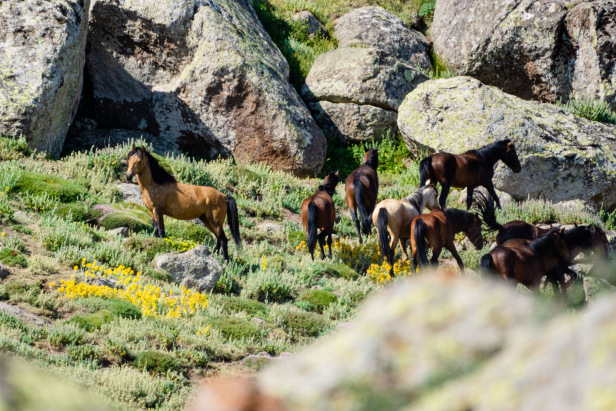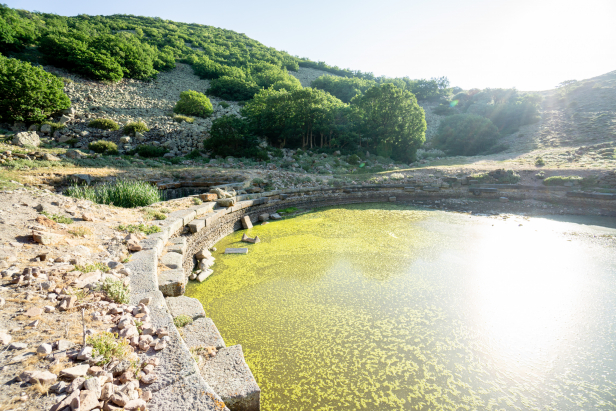Binbirkilise and Mount Karadağ
(Binbirkilise ve Karadağ)
/ By Josh
Cost: Free
Great for: Hittite History, Byzantine History, Byzantine Architecture, Gertrude Bell
Breaking the monotony of the wide-open plains of Central Turkey, Mount Karadag, meaning “Black Mountain”, towers 1,200 meters above the flat cultivated lands. An extinct volcano of many peaks centered around a great central crater, the unique landscape of the mountain became home to millennia of settlements and the unique architecture of what would become known as Binbirkilise, or The 1001 Churches.
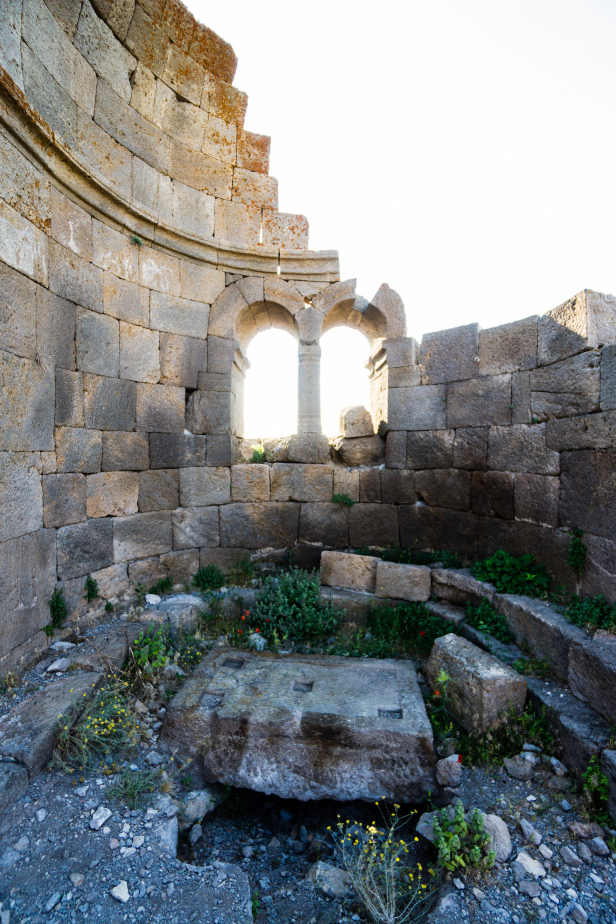
What little we know of Binbirkilise is thanks to the work of Sir William Ramsay and Gertrude Bell who, from 1905 to 1907 conducted surveys in the region and released their findings in the book “The One Thousand and One Churches”. Now, over 100 years later, their book and the numerous pictures, are still the best resources on the subject. While Binbirkilise gained some attention following the release of Ramsay and Bell’s book, it has remained rather unknown in Turkey as well as the rest of the world. In fact, it’s often eclipsed by the Ruined Armenian City of Ani, which has also been referred to as the City of 1001 Churches.
Subscribe to The Art of Wayfaring
History of Mount Karadağ
Apart from the pre-historic volcanic activity that formed the many peaks and craters of Mount Karadağ, the history of the area begins with the Hittites who left monuments and inscriptions on the peaks. Just to the north of the main body of Mount Karadağ, on a lesser peak is the Neo-Hittite monument of King Hartapu, dated to the 8th century BC. On the Malahaç peak of Mount Karadağ are the remains of another larger Hittite site. The Malahaç site was built over by Christian monks, making one wonder how many other Hittite sites may have been lost on Karadağ. Pre-classical pottery remains found at Madenşehir show that the area was settled before the Hellenistic period.
While classical remains are few, they are rather unique, consisting of a pair of large mausoleums in Lower Madenşehir and a Roman Fort at the peak of Başdağ on the south of the central crater.
While the history of Mount Karadağ has deep roots, it was in the Byzantine Period that Karadağ truly flourished with a great push to build churches and monasteries in a style unique to the area, giving rise to its modern moniker: The 1001 Churches.
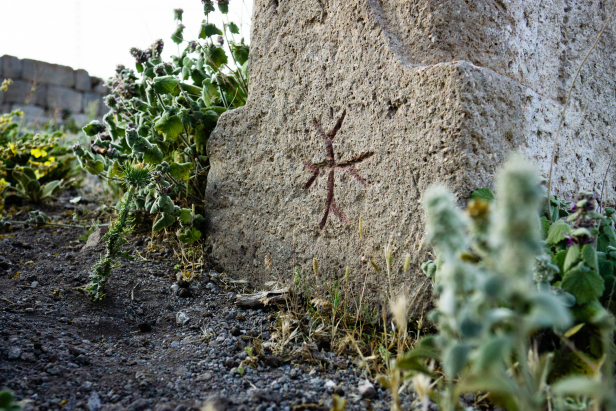
Beginning sometime around the 5th century, the people who lived on the north slopes of Mount Karadağ, now Christianized, began to build churches in the towns and mountain peaks. The building of churches and monasteries on the peaks was a continuation of the ancient customs where the mountains were seen as the sacred sites of mountain, sky, weather, and storm gods from the earliest civilizations.
Though vaguely following the forms of early christian and roman architecture, the churches built at Karadağ became a class unique to the area. Churches built over six centuries followed this template despite the passing of years and the shifts of rulers.
The 1001 Churches of Karadağ are centered on the town of Madenşehir, meaning “Mine City”, though there is no trace of any mining. The ancient name of the city is apparently forgotten though Ramsay has suggested that it could be Byzantine Barata. This, however, is not yet settled.
With walls ringing the site, the settlement built on a wide shelf above the current village was the defensible early city, built before the stability of the Roman period. As law and peace increased the settlement expanded down the hill into the plain where only tombs had once been.
By the 6th century AD there was again war and instability in the region with the Arabs expanding into Byzantine territory and raiding deep into Anatolia. At this time the lower city at Madenşehir was abandoned in favour of Değle (Üçkuyu), built on a high spur with a view over the plain from near the lip of the Karadağ Crater. The new settlement was built in the same style as the previous with churches and monasteries dominating though the skill of the craftsmen had by now diminished.

From 850 to 1070 AD there was again a period of relative peace in the region and the abandoned churches of Madenşehir were restored. In 1072 Byzantine rule of the region came crashing down with their defeat by the Seljuk Turks at Manzikert (modern Malazgirt) and the settlements, churches, and scattered monasteries of Karadağ came under Muslim Seljuk control.
Sometime after the Seljuk conquest, the Turks moved into the upper settlement at Madenşehir while the Greeks continued to inhabit the lower for another hundred years or so. While the land remained settled, the population dwindled in size and wealth. While the town grew again after the Greeks had left, the wisdom of centuries of tending the difficult land was lost and the mountain slopes are barren where there were once orchards and vineyards.
Over the course of a few years in the beginning of the 20th century, a research team led by William Ramsay and Gertrude Bell carried out detailed surveys of the region surrounding Karadağ, and witnessed the sad destruction of many buildings that had stood through the centuries, only to be looted for stone to build houses and barns. Some of Bell’s pictures are the only record of churches that are now lost.
Today, over 100 years after Ramsay and Bell’s survey, the site has still not been excavated except for some small sections and their book, The 1001 Churches, is still the most in depth work regarding the area.
The book is available for purchase from The University of Pennsylvania.
Why Visit?
The 1001 Churches
The romantically named 1001 Churches is a somewhat difficult thing to define. The slopes of Karadağ are home to a number of scattered settlements though most often 1001 Churches is used to describe those at Madenşehir and Değle as well as the mountaintop monasteries. The term 1001 is used to express a multitude rather than a literal 1001 (as in 1001 Nights, aka The Arabian Nights)
About the architecture
While the churches here were built over a long period of time they form a single stylistic group, one that is quite unique from the classical influence that evolved into the byzantine style. Stone vaulting was commonplace as wood would have been scarce. Domes, semidomes, and arches are most often horse-shoe rather than Romanesque, and the majority of churches include a narthex. Basilica churches are three-aisled with rectangular double columns separating the aisles, and adornments are simple, usually consisting of mouldings, simple capitals, and engraved crosses. While the churches stand large and proud they are crude in their details, the mouldings irregular and often crooked. Limited to basalt, a stone that doesn’t lend itself to intricate patterns, the masons at Mount Karadağ were not as skilled as their counterparts that made use of marble.
Madenşehir Sites
Set at the northern foot of Mount Karadağ Madenşehir is the largest center of the 1001 Churches and home to the most impressive surviving buildings. The upper section of the town was fortified and had five churches, though little of this remains, with Roman, Byzantine, and Turkic ruins jumbled together.
Basilica Church
The largest church in the 1001 Churches region is the Madenşehir Basilica, blending the classic basilica pattern with the style of the Karadağ region. In typical basilica style there is a high vaulted center aisle flanked by two lower aisles ending in a semidome apse. The vault is barreled though the ribbing is horse-shoed. The church is entered through a narthex with two arched doors. While the majority of Christian buildings use triple doors and windows (three being a reference to the Trinity), the basilica here and numerous other churches have double doors and windows. The lower side aisle allowed for windows in the upper walls of the central aisle to allow more natural light.

The basilica was damaged and altered already some time in history, a vault built within the vault to keep the roof from further collapse, though this inner vault has now been cleared away. The ruin and subsequent repair suggests that the church was abandoned before the 8th century and repaired when the population was able to move back into the lower city some centuries later. The south wall of the church has been completely lost though the remains give a clear sense of the original state of the building.

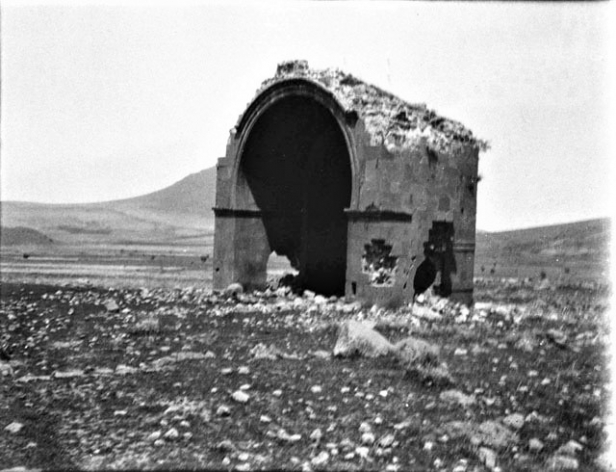
On the outskirts of Madenşehir, immediately visible to the south are the remains of a massive complex simply referred to as “Church 7”. The complex consisted of a large basilica, much like the Madenşehir Basilica with a massive freestanding apse connected by a small wandering wall forming an enclosure where many graves were discovered. The apse is the best preserved and finest structure in the region, remaining unchanged since Gertrude Bell photographed it 100 years ago.
Mausoleums
Within the lower town are a pair of mausoleums, dated from at least as far back as the Roman period. Built with large blocks and fitted tight without mortar they are unique for the area. Ramsey believed that what remains was only the tomb chamber, a sort of plinth that was once topped by a small pyramid.
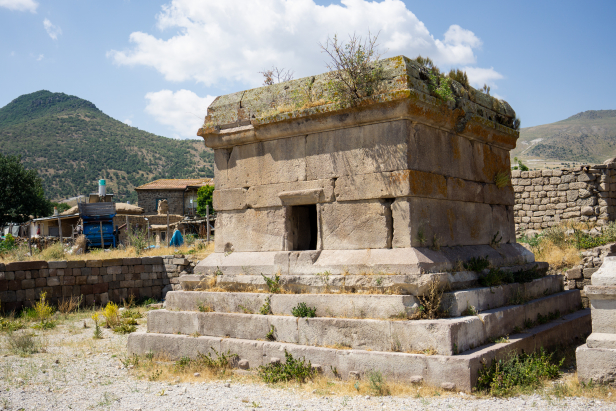
Beyond these main sights there are numerous other ruins scattered among the crude buildings of the village; the occasional fine doorway still peaks out from among the rubble. Some of these are churches, others would have been homes, and the remains of what was once a fort.
Değle / Üçkuyu Sites
Built on a high knoll to the west of Madenşehir is the site of Değle, now the village of Üçkuyu. Here the sense of abandonment and ruin is even greater than what is found below. Not only are the ancient churches ruined and forlorn but even the modern village has dwindled down to a few households that hang on to life in the village. The church and monastery buildings here are overall much smaller and the masonry much poorer though the style and designs are similar, carrying on the themes of the buildings below.
Churches surrounded the outer rim of the hill and were connected by an irregular wall, with the churches often set like towers in the fortification.
Gate Church and Chapel (Church 33 and 36)
Today the road up to Değle winds below the settlement, to the left and enters through the back. Historically this road ran straight up, entering through a sort of gatehouse formed by walls that connected a small chapel, church, and other lesser buildings. These sit on the brink of the hill on the eastern edge of the village and are visible as you drive up the road from Madenşehir. Little remains of these buildings, though the apse, with its deep-set twin windows are in fair condition.

Church set on spur above road (Churches 31 and 42)
Crowning a small spur of land jutting out to the south of the village is another church set like a watchtower. The church is typical in design with a well-preserved narthex and apse. The double pillars and some of the side rooms are still intact though the vaulting has collapsed. When rubble was cleared in the early 20th century some traces of fresco could still be found. The lower portions of the fortification walls can still be seen connecting the church here to a small chapel nearby.
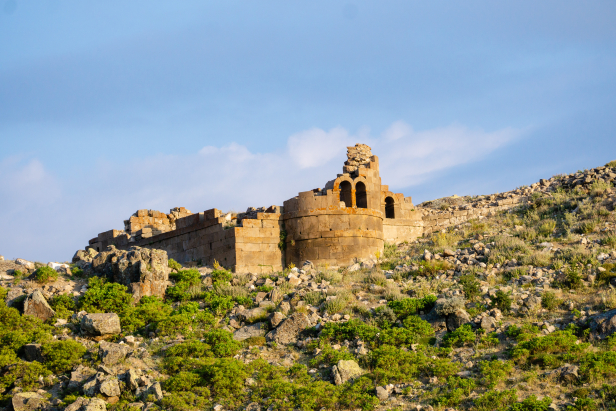
Large Church in Middle of Diğle (Church 32)
Sitting near the middle of the village is one of the most ornate in Değle, with a cross medallion above the entrance, fine patterns adorning the crowns of the short double-pillars, and more precise moldings. Unfortunately, the church suffered a great deal of damage between 1905 and 1909 and later again over the past century.
Today the narthex, aisles, and apse are still standing, though the vault has collapsed. The triple arched windows in the apse are built with irregular blocks without any proper keystone.
Mosque
The exact history of the old mosque here in Üçkuyu (historically Değle) is murky. The design is unusual and has clearly evolved over time, with walls butting against each other poorly as new sections were added over time. The mihrab is built off center to the right, leaving no room for a Mimbar and partially covering what appears to have been a doorway. The center aisle is also off of center based on the peak of the gables. Whatever this building began life as it was likely not a church as it lacks any trace of an apse in the east end and the church is not oriented on an east-west axis like the rest of the churches here. Most likely it was a fine building that the later Muslim inhabitants chose to use as a mosque as its orientation was already towards Mecca.
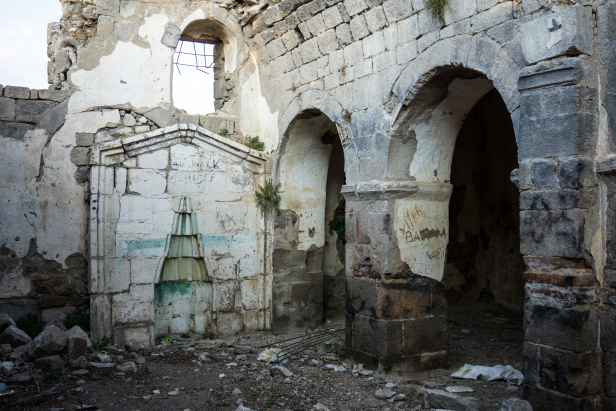
According to one local, the mosque was the town’s primary place of worship until the 1970s when the roof caved in and a new mosque was built in the lower town. Photos from 2013 show the stone vault of the central aisle still standing, though it has since fallen as well.
Tombs
Near the south-eastern edge of the town is a set of tombs. Among them is a rather interesting sarcophagus cut into the bedrock with a crude scene carved into its face depicting a plowman behind oxen and another figure holding a sack and scattering seed.
To the south from the plowman’s tomb are a pair of well-built chamber tombs, consisting of heavy stone walls and a peaked roof of thick stone slabs.
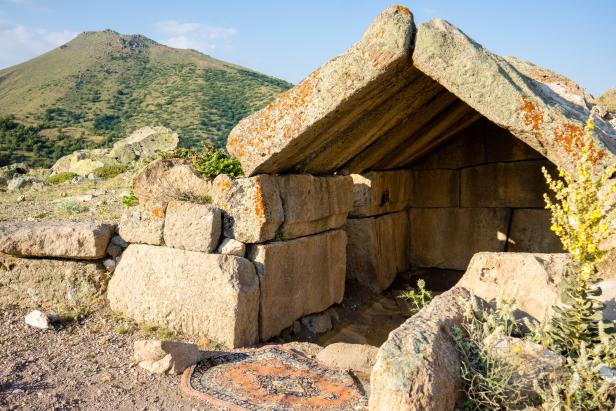
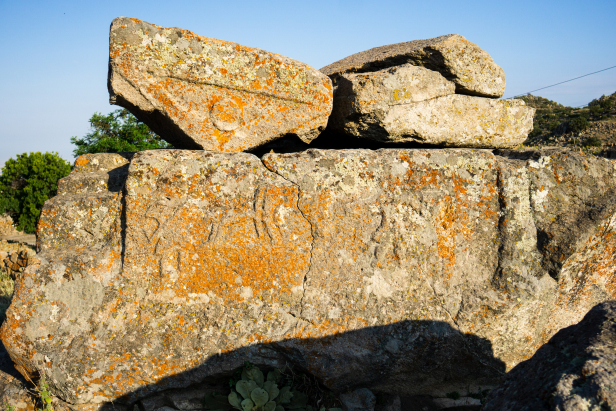
Beyond the specifically described churches here, there are many other buildings, some reduced to heaps of rubble, or renovated to make for homes, and here and there the odd arched chamber, door post, or apse shows itself.
Yılkı (Mustang) Horses
Wandering among the peaks and craters of Mount Karadağ, a herd of horses known as “yılkı” meaning mustang, or feral, can often be spotted. When tractors began to replace animals the sheltered bowl of the crater and grassy slopes became a home to the abandoned animals. The area is vast with many peaks to hide behind making it sometimes difficult to find these mountain dwellers.
Roman Fort and Pool at Başdağ
The most significant remnant of a Roman presence at Mount Karadağ can be found on the top of the towering peak of Başdağ, or “Head Mountain”, which rises from the southern side of Mount Karadağ. The Romans took advantage of the high peaks’ view of the surrounding area, building a series of small forts and castles around the summit.
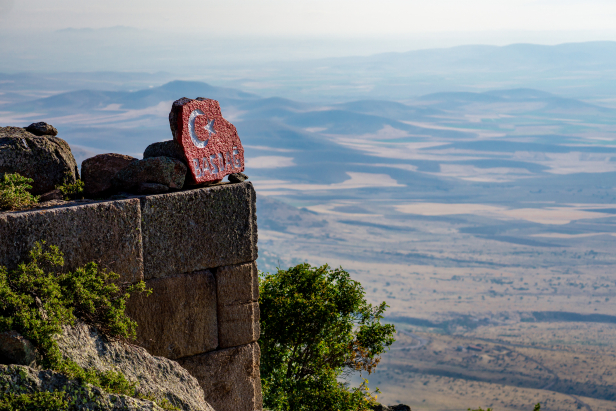
There are barracks and other smaller buildings near the road that passes into the crater as well as fortresses on the northern and southern peaks. The northern one is the better built with strong towers at its corners while the southern one is inferior and irregular despite being the more logical place for a watchtower.
The top of Başdağ is a deep-sunken crater, at the bottom of which was built a large round pool with a smaller rectangular pool next to it. Other than to store water, it’s unclear exactly why such a wide and finely built pool was built here. Shepherds have broken down a section of the lip of the pool to allow animals to enter and get at the water in what is otherwise a very dry gravely landscape.

At the foot of Başdağ is a small poorly preserved settlement with the remains of churches and other buildings. While these are not usually included among the 1001 Churches of Mount Karadağ, they appear to have been built around the same period and are obviously connected. The name of this place is unclear but possibly Nağran Ören as identified by Ramsay (though he writes it “Naghran Euren”).
Summit Ruins
The ancient peoples of Turkey, the Hittites and their neighbours, often built their sacred sites on the peaks of mountains or unusual promontories. This tradition continued down from the Bronze Age, into the Classical Period, and even into the traditions and practices of the Christian Byzantines. Mount Karadağ was once rich in sacred sites of both the Hittites and their descendants. While many of the peaks surrounding the crater of the extinct volcano have traces of chapels and shrines, by far the most interesting site is on the peak known as Mahalach.
Mahalach Peak
Mahalach (Mahalaç, thought to be refer to the Archangel Michael), is home to a Byzantine Church complex built on top of the remains of an ancient Hittite sanctuary. Chapels, churches and lesser buildings were connected with walled tunnels, designed to protect the monks from the extreme cold and wind here on this high peak where snows linger late into spring. Photographs from 1907 show a standing church, whereas when surveyors visited again the next year the upper portions of the buildings had collapsed.
Little remains of the Hittite sanctuary, though a hieroglyphic inscription was found connecting the site to King Hartapu, who built another monument on nearby Kızıldağ, just to the north of Karadağ.
Access to the Malahach Peak site has been restricted by the building of a radar station on this hill.
How To Get There
General
As most of the sights on Mount Karadağ are fairly remote, your best bet is to access them by car, ideally one that can handle the rough roads that pass through the mountain. The main group of the 1001 Churches can be visited in the town of Madenşehşir. The Değle sights are found in the modern village of Üçkuyu, 7 kilometers to the west of Madenşehir. The Roman Fort and Pool at Başdağ can be reached up a rough gravel road passing by the village of Kılbasan on the south side of the mountain.
For more about car rental and driving in Turkey make sure to read our full drivers guide.
Where To Stay
There is no accommodation in the villages around Mount Karadağ. The closest center with any choice of hotels is in the City of Karaman, about 30 kilometers away.
Other Tips
Planning on visiting the sights of Mount Karadağ and the 1001 Churches? Make sure to check out what other sights are in the Province of Karaman, nearby Konya Province and the Hartapu Monument on Kızıltepe.
Subscribe to The Art of Wayfaring
Have any tips or info to add? Spot any mistakes? We’d love to hear about it.


